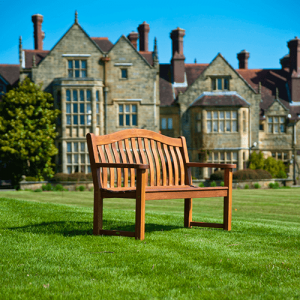
Guide to Looking After Your Wooden Garden Furniture
Wooden garden furniture can be an excellent addition to any outdoor space, and the variety on offer makes it very easy to tailor your garden to your personal style or preference. However, most of this garden furniture – wooden or otherwise – also has to endure a lot of punishment from the natural weather that constantly surrounds it. Wood furniture in your garden can be very vulnerable to a sudden change in temperature or weather, so it is often important to make sure that you are properly caring for your wooden outdoor furniture if you want to avoid wear and tear over time.
Understanding the Problem
Natural wood is always going to produce natural oils, some of which can technically protect it from certain types of wear. However, wooden garden furniture is not the same as a natural tree trunk: after being cut down, treated, and built into a piece of garden furniture, wood is hardly as durable as it used to be and doesn’t have the natural growth of a tree to repair any long-term damage. Some people quite like to have their wooden furniture slightly worn, but even if that is the case, you still have to prevent damage that can outright weaken or rot the materials and make the garden furniture unusable.
There are a lot of threats that can temporarily or permanently damage your garden furniture, including:
- Rotting and water damage, which makes it much weaker.
- Warping, also from water, which can ruin the design.
- Fire, which can destroy the furniture.
- Sunlight weathering, which can alter the original colour and finish.
- Physical impacts.
- Pests that eat (or live in) wood.
It is better to prevent these issues ahead of time rather than trying to fix them once they have already happened. One of the best ways to handle this is through treating the wood, adding extra protection that won’t strip away under most normal weather conditions.

Treating Wood
Treating wood is relatively simple, although different treating chemicals and products can vary slightly in how they are meant to be used. Either way, preparing the surface is always the same: first, clean the furniture with some hot, soapy water (or hardwood furniture cleaning fluid) to get rid of any superficial marks or things that might get in the way of the treatment.
Applying the Treatment
It is best to do this at the start of the year so that it will be treated in time for the summer heat. Try to apply the hot soapy water by hand if you can, or with a pressure washer on the lowest possible setting if you really have no other option. Then, try to lightly sand the surface and brush away any dust: this flattens down bumps and provides an easier surface to work with.
Always make sure that your garden furniture is dry before you move ahead since moisture can interfere with the oil you use to care for the material. When you think your furniture is ready, apply the oil (or whatever other treatment product you are using) with a brush like paint, making sure to follow the direction of the grain.
When it is dry, you could potentially do another layer, although you shouldn’t use the furniture until two days after the last coat.

What do I treat it with?
There are two main ways to treat wood: penetrative wood treatments that soak into the material, and exterior coating treatments that form a shell. The former is much easier to use and can be re-applied as soon as it needs another coat, but the latter can be far more durable and is not going to wear out as quickly. Both are a good option, so using either can provide great protection to your wooden surfaces.
- Oil is the most common penetrative, and comes in a huge range of different brand varieties. They replace the old natural oils that weather damage can remove, allowing the wood to “protect itself” a bit better.
- Stains enhance the natural grain and improve the vibrancy of the wood, restoring the look and colour of your furniture’s surface even after being hit with strong sunlight or water-related wear.
- Restorer is used to strip away any weathered wood and give you the normal materials underneath.
Teak Oils
Some products, like Teak oil, use real Teak wood in them to revitalise other types of timber. Teak oil is just one of many specific options, but products that use Teak and other wood-based blends can be quite effective on furniture. You can even use this Teak product on any teak garden furniture you own. Certain brands might try to have an all-rights-reserved monopoly on certain formulas or mixtures, but there are usually alternatives if you need something cheaper or more accessible.
Hardwood and Softwood Care
Hardwood furniture and softwood furniture might look like similar items, but they handle protection in a very different way.
Hardwoods
Hardwood is far more durable and can maintain good quality for longer, even during winter months when the surface is constantly battered and moist – some can even be treated with little more than some warm soapy water once or twice a year, then a little rinse. Choosing to treat it can still help, but care is a lot easier if you can get hardwood furniture.
Softwoods
Softwood, by contrast, is much more sensitive. Trying to treat softwoods means having to apply certain chemicals or blends, often with a brush, and they rely a lot more on protective coatings or covers. Hardwood isn’t inherently better than softwood, and both can be good in their own ways, but trying to treat or cover them may require different steps. Trying to remove an existing coat of oil or paint can also require different methods if you want to avoid damaging the surface underneath.
What about metal garden furniture?
You might be wondering why metal garden furniture matters in an article about wood garden furniture, but the two are almost always linked. When you need to care for wood furniture, you will also probably be going to have to care for metal furniture parts as well. A lot of weather-resistant outdoor furniture will still have metal parts that can rust and require maintenance, and not doing this maintenance can make even well-made steel and aluminium parts break down. There is also the fact that you will probably want to clean all your garden furniture at the same time so that any aluminium garden furniture that you own will also need care.
Cleaning
Trying to clean metal is basically the same as cleaning wood: just use at least one sponge and a container of warm, soapy water. Rough scrubbers don’t help and can make your cleaning efforts worse, causing rust (sometimes even on treated steel or materials that aren’t normally that susceptible to rust). Once again, a pressure washer can work as long as you keep the power very low: even tough metals like steel can be damaged if the water is high-pressure and concentrated.
Rusting
Aluminium garden furniture won’t rust, but the metal can still suffer from oxidation, which changes the colour. This can actually make it stronger in terms of durability, but the colour change isn’t appealing to most people, so cleaning it regularly can maintain the same look for years. Most oil-like protective treatments need the metal surface to be dry before you can apply a new coating.
How often should I care for my garden furniture?
Most people recommend that you make sure to lightly sand, clean, and treat your wooden garden furniture at least once per year, but you should also make sure that it is enough for your garden furniture. Particularly bad winter months or issues with keeping the timber dry can require you to do it more often in certain years, and waiting an arbitrary amount of time between garden furniture care and maintenance can lead to issues with you missing obvious problems or signs of damage.
Coatings
Protective coatings on garden furniture don’t always wear out at the same rate, nor do garden furniture paint layers (regardless of colour). Even protective paint can need a re-paint much sooner if it has been up against cold and windy winter weather, so you may want to take a look at your garden furniture every so often just in case. In years where weather is harsher, your garden furniture might need care more often: to restore the paint, to make sure that the natural oil is replaced, or just to keep it clean.
Older Furniture
Old garden furniture might need a clean more often than new garden furniture, especially if the wood has already been damaged in the past. With new garden furniture, you might also be able to skip treatment for a while if it comes with a new treatment coat, but it is still a good idea to keep an eye on when it might need a new coating just in case. Keep in mind that old wood garden furniture won’t always be made to a modern standard, so you may remove more of the surface than you expected while cleaning or end up stripping away old paint unexpectedly.
Treating Your Garden Furniture
The best way to make sure you are using the right techniques is to search up advice for that specific piece of furniture, or at least the materials that it is made from. Each guide you find during a search might recommend using a certain oil or handling your wood garden furniture in a particular way, so it can often help to search up a guide or some advice that is specific to your situation.
Of course, when working with garden furniture, you can often get by using some basics that cover most situations. For example, using a decent oil treatment can provide more protection to your garden furniture with no major downsides, and cleaning a surface to remove dirt is generally a good way to make it last longer in general. Garden furniture can be under a lot of wear in even the calmest weather, and applying a basic protective oil might make a big difference.



